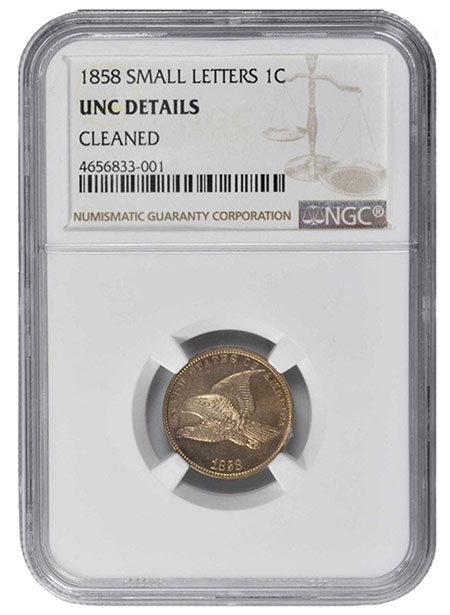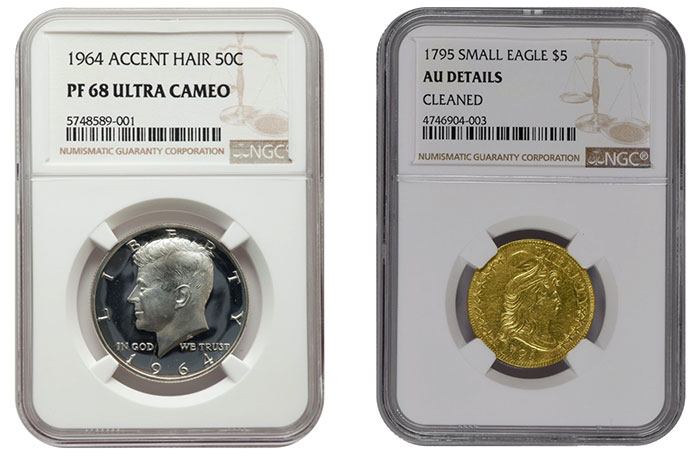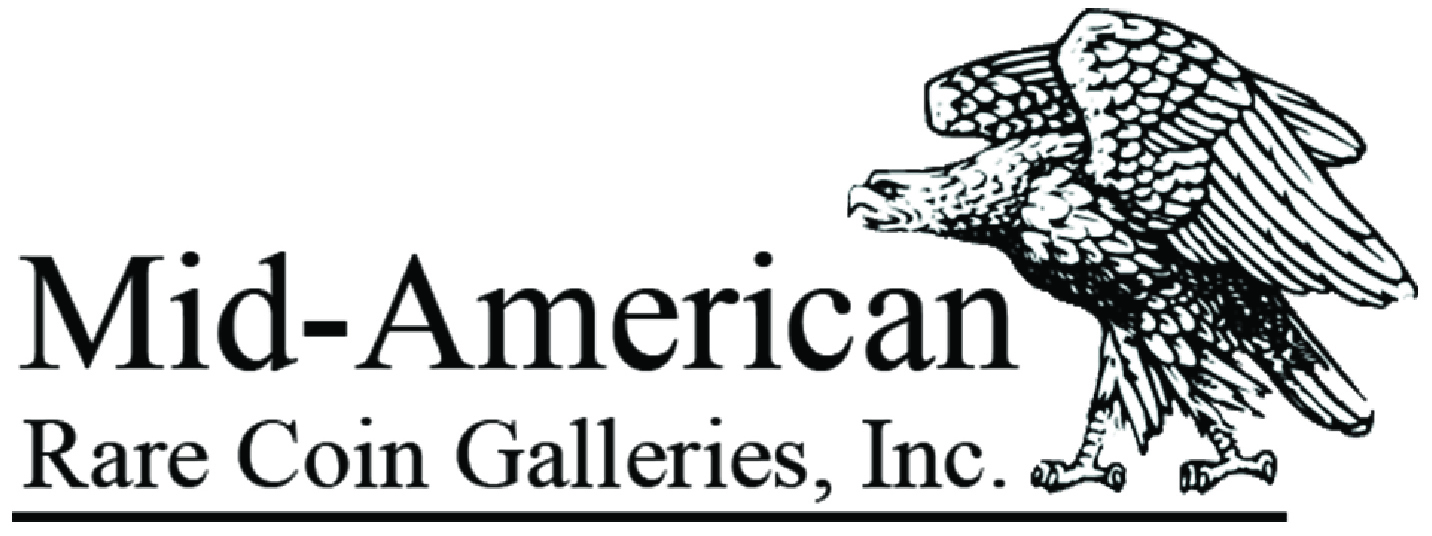For the first 20 or so years that NGC graded coins, any pieces submitted that were deemed unacceptable for certification were returned in a plastic sleeve. These became affectionately known as “body bags”. As the term indicates, receiving these was quite an unwelcome result after having paid a submission fee.
Many submitters simply did not understand what may cause a coin to be ineligible for grading. Sometimes even the savviest dealer would miss brush lines or some sort of environmental damage. Anyone who submits coins for grading knows that they may or may not be happy with the grade, but everyone hated a coin coming back “no grade”. Not only was it a waste of time and money, but the coin was also basically unsalable without certification.
 To alleviate the problem, NGC began to holder coins with problems through Numismatic Conservation Service (NCS), an affiliate company of NGC. The coins were put in a specially designed NCS holder. These are still seen quite often in the marketplace. However, NCS no longer performs grading and encapsulation. More recently, NGC began placing coins with problems in its regular holders with what is called “Details” grading.
To alleviate the problem, NGC began to holder coins with problems through Numismatic Conservation Service (NCS), an affiliate company of NGC. The coins were put in a specially designed NCS holder. These are still seen quite often in the marketplace. However, NCS no longer performs grading and encapsulation. More recently, NGC began placing coins with problems in its regular holders with what is called “Details” grading.
Details-graded coins are not graded on the numeric 1-70 Sheldon scale. The piece is described by the details the coin would have for its grade were it not for the problems as diagnosed by the NGC graders. A silver dollar may be certified as follows: Uncirculated Details – Improperly Cleaned. Other issues that are often called out include environmental damage, repair, harsh cleaning, scratches, and whizzing. A complete list of surface issues that are utilized for Details grading can be found on the NGC website.
NGC does not holder coins with altered surfaces. These include coins with foreign material that has been added to the surface. Of course, counterfeits and coins with added mintmarks or altered dates are excluded as well.
As mentioned above, one of the primary reasons that people submit coins knowing they will be subject to Details grading is to increase liquidity. Third-party grading has become extremely entrenched in the minds of most collectors. Purchasing a coin for over $500 that has not been certified is out of the question for the majority of buyers due to the proliferation of counterfeits that have entered the marketplace.
Nearly every day, we have someone call about a coin that is an obvious counterfeit of Chinese origin. A coin with Details grading will certainly sell for less than a coin given a numeric grade, but at least it becomes saleable.
 Details-graded coins can also be an attractive alternative for collectors seeking completeness of a set but who need to consider affordable alternatives for expensive issues. For example, Large Cent collectors can complete a set for a relatively modest amount with the exception of a few dates. The 1793 Chain Cent alone starts at five figures for a nice example to which NGC has assigned a numeric grade. High-grade coins can run into six figures. Low-grade examples of the date can be well worn with little eye appeal.
Details-graded coins can also be an attractive alternative for collectors seeking completeness of a set but who need to consider affordable alternatives for expensive issues. For example, Large Cent collectors can complete a set for a relatively modest amount with the exception of a few dates. The 1793 Chain Cent alone starts at five figures for a nice example to which NGC has assigned a numeric grade. High-grade coins can run into six figures. Low-grade examples of the date can be well worn with little eye appeal.
Buyers for the series may wish to consider a coin that NGC has assigned as Details-graded. The coin may have surface issues, but the design elements can be well-defined. This can be more appealing than a coin with barely discernible design details. The same can be said for the key date issues of about every series.
Establishing values for coins with NGC Details grading is probably the most difficult aspect. Current price guides do not give information about Details-graded coins. There is also the complication that there are dozens of reasons and varying degrees of Details grading.
A coin that has been graded Uncirculated Details – Improperly Cleaned may be only slightly below the standards acceptable for NGC numeric grading. Another coin with the same grading designation may display much more surface cleaning. Buyers of NGC Details-graded coins need to determine value based on a coin’s eye appeal.
In general, coins with Details grading sell for substantial discounts compared to those with NGC numeric grading. Anyone interested in purchasing a Details-graded coin should do research to determine value. Most auction company databases have images and prices realized of nearly every expensive issue. For example, there are literally dozens of 1793 Chain Cents on the Heritage Auctions’ website that sold in the last 10 to 20 years. Buyers can do comparison shopping to get an understanding on how to establish values for this scarce issue.
The 1793 Chain Cent above was graded by NGC as Fine Details – Environmental Damage. The coin sold for $5,405 at the 2015 FUN show. A coin that has been graded by NGC as Fine 12 or Fine 15 would sell for $25,000 plus. This is about a 75% discount to the average selling price for numeric graded examples. The value for some collectors is clear.
In a world where quality is of paramount importance, NGC Details-graded coins are not for everyone. They are, however, a very affordable alternative that many collectors find appealing. Coins that may have been out of reach might be found for a price that makes sense. The biggest drawback is that Details-graded coins lack the liquidity of coins with numeric grading.

NGC-certified coins with numeric grading can be sold over the phone with quick descriptions of their appearance. The same cannot be said for NGC Details-graded coins. Most coins are different, and value will be a matter of opinion. Regardless of the drawbacks, an NGC Details-graded coin may be the best chance to snag that key date coin you have always wanted but could not afford.
